But with the gigantic outpouring of global attention that the Floyd case received — and with virtually every major elite US institution united in both their condemnation of the death-inducing act, and their claimed resolve to continue doing unspecified reparative "work" — it would be foolish to not also notice the comparatively miniscule attention that other instances of unjust killings receive. If one unjust killing (Floyd) generates sustained, historic, society-altering attention, and hundreds or thousands of others generate virtually no attention, the reasons for that disproportionality have to reflect something about a society's cultural and political priorities.
This is especially true in Minneapolis, where the tumult of the Floyd episode and its fallout has now lasted for nearly a full year. Because it simply cannot be disputed that the prevalence of unjust killing and violence in the Twin Cities area has vastly increased since last summer's protests and riots. Minneapolis recorded its second-most homicides ever in 2020 — after only 1995, when the city was ignobly dubbed "Murderapolis" in national media. And the trend has continued to escalate in 2021: between January 1 and April 25, the number of homicides increased by 92% compared to the same period in 2020. More than 80% of the shooting victims in 2020 were black.
"We're gonna blow Murderopolis off the charts this year," one Minneapolis cop told me. (Names in this post have been withheld or partially redacted. As you may be aware, there is often intense suspicion of journalists amongst both civilians and police.)
The situation is roughly the same in Saint Paul, which tied its all-time record for homicides in 2020. This year, it is on pace to break that record comfortably. The latest homicide was on Sunday night; a man was shot and killed outside a bar in an apparent carjacking. I visited the bar the following day and there was hardly any sign something was amiss — the manager only insisted that the killing had nothing to do with the bar. (Carjackings in the area have surged to an astronomical degree, as I can personally attest. See below.)
Another Minneapolis cop told me:
"There's way more people it seems like with guns now than there ever has been, much less hesitation to use them. They feel emboldened and they feel untouchable, in my opinion."These officers theorize that the explanation for the crime surge is related to the city's political climate over the past year, which in their view has allowed perpetrators to wreak havoc without consequence.
Yes, it's true: police are generally not credentialed experts in criminology or sociology, and their theories for complex multi-causal phenomena obviously should not be taken as gospel. Still, it is worth incorporating their viewpoint into any assessment of the overall situation. Just as it's worth taking into account the perspectives of non-police citizens who virtually never factor into national media narratives — narratives which are usually crafted by elites who live in affluent areas that undergo little or no violent crime. And while they express it differently, regular citizens (including non-whites) often have a similar perspective as police on the issue of crime prevention.
On Sunday afternoon, April 25, a woman and her husband were sitting in their truck outside her place of work in North Minneapolis. The woman is employed as a home elder care assistant. Without warning, a fusillade of high-powered shots rang out around them; two of her children were also in the truck. She had to shout:
"Get down, get down. My kids was crying because they didn't know what was going on... they scared."Another witness told me of when he first heard the shots:
"I was right by my front door. I could feel the sonic boom. Big fucking guns, war guns," he said. "Afghanistan guns."Seconds after the firing erupted — 15 or 20 shots in total — the woman and her husband saw an elderly man who had just walked past them on the sidewalk staggering back in their direction, now suddenly bleeding from the neck. They rushed up to him, guided him to sit down on some front steps, and tried to stanch the bleeding while they called for an ambulance.
In all likelihood, this was a random bystander who'd been struck. A police spokesperson later told me the injury was non-fatal — I happened to be close by at the time of the shooting, and I watched EMTs roll him into the ambulance on a gurney. It certainly looked like the injury would've been fatal in another few minutes had there not been a speedy medical intervention.
The woman who had helped the elderly man was crying.
"Yes, I'm upset. And I'm hurt because I just witnessed a man shot in his neck," she said. "My take about this is it's crazy. Like people is getting killed for no reason. Innocent people."When asked if she thought this sort of thing was happening more frequently than usual in Minneapolis, she said: "Yes, way more."
Kevin C. is 22 years old and lives with his younger sister in their great-grandmother's house off Lake Street in South Minneapolis — the epicenter of last summer's riots and protests. He was a protester himself, and even had to jump out of the way during an infamous incident when a tanker truck nearly barreled into the crowd he was in on the interstate.
Now almost a year later, he told me his current preference is for police to be more aggressive in curbing indiscriminate violence in his neighborhood. A few weeks ago, he said, there was a shooting in the alley behind his house — bullets were flying just yards from him and his sister.
"The police came, but they didn't really like, investigate. They just shined their lights and then drove off."He said he'd noticed a steep decline in police presence lately, especially after last week's trial of Derek Chauvin ended with a guilty verdict. "Even before the trial," he said, "they would drive through here, but there wouldn't be any, like, policing going on."
Kevin said he and his family uniformly wanted police to be more assertive — in the sense of addressing genuine threats to public safety such as shootings, though without any extraneous harassing behavior thrown in.
"Honestly, we just want them to do what they supposed to do. All the extra stuff, you can just keep. That's for the birds. If there's a problem, and we're contacting you to come check it out, we expect you to do above and beyond the call of duty. Not — you know what I'm saying — do what they usually do. Just come over here, flash a light, and speed off."He is shortsighted, and said the eyeglasses store he used to go to down the street has been permanently shuttered since last summer.
Minneapolis cops tend to agree that the primary reason for this surge in crime is that their resources have been stretched precariously thin, as a result of widespread anti-police sentiment since the George Floyd episode. One cop told me:
"It's kind of like the Wild Wild West out here. Usually a cop should take about ten calls a day," he said. "I'm already at like, thirty. So that's way overboard. I mean, you're gonna have burnout. You're gonna have people quitting.Fourteen officers had left in just the past week since the verdict, he said.
"One of us is gonna get killed and nobody cares. And that's what's sad. Nobody cares. Not the citizens, not our brass. Not our administration, not our city. They don't care. They don't care one bit."
The Target store where much of the rioting first kicked off last year is now adorned with a corporate-sponsored artistic mural that appears to glamorize the burning of the Third Police Precinct building, which is located right across the street.
The cop said he expects an even more concerted round of mass resignations the next time a "big incident" happens wherein the cops are portrayed in a negative light:
"We're getting fed up. All of us. And there's only a few of us left that really want to work for the city. We're not gonna be here. We're gonna all leave. So this is gonna get worse before it gets better."The Minneapolis Police Department didn't specifically track carjackings as a unique category of crime until September 2020. A retroactive analysis showed a 537% increase in carjackings in one month — November 2020 — compared to November 2019. Yes, you read that correctly: 537%. (I haven't independently corroborated this data, and it may well have been imperfectly collected, but a substantial increase seems beyond dispute.) Additional data given to me by police show that carjackings are up 180% year-to-date in 2021 between January 1 and April 25.
I was sitting in my car in South Minneapolis on the afternoon of Sunday, April 25 when a young man appeared at my driver-side window. He banged on the window and motioned for me to roll it down. With the window still closed, I repeatedly asked him what he needed. He continued motioning for me to roll down the window, without verbalizing any request. Cognizant that carjackings were on the rise, and seeing the young man's hand conspicuously concealed inside his front hoodie pocket, I drove off. As I looked in my rearview mirror, two other young men popped out — unbeknownst to me, they had encircled my car. I can't say for certain that it was an attempted carjacking, but I don't know what else it would've been, and everyone I have described the incident to (cop and civilian) affirmed that it had all the hallmarks of an attempted carjacking.
NOTE: I am not traumatized by this incident. I am not declaring myself a benighted victim on account of this incident, and I am not otherwise requesting any special accommodations in relation to this incident. I'm simply relaying it as a thing that coincidentally happened 'while I was in the process of reporting on crime patterns in the Twin Cities area' — and which was consistent with the tactics reportedly employed to execute carjackings, which have demonstrably surged.
The potential attempted carjacking incident occurred as I was going to gather more information about a recent Minneapolis murder victim, Maria Elena Mantini. She was 78 years old, and stabbed to death at a bus stop on the morning of March 17, according to police. Two other people are thought to have been stabbed by the same suspect; they both survived.
There's little information about Mantini in the public record, so I went to the apartment building in South Minneapolis where she lived. Several acquaintances had noticed her absence, but were completely unaware that she'd just been violently killed. They'd received no notice.
Mary, a resident of the apartment building said she often hangs out in the lobby to help "keep the riff-raff out."
"I was friends with her. She usually came to you when she had a problem. I didn't know that she was killed. I thought she died of natural causes."According to T.Y., the lobby companion of Mary who resides in the building and also works security at the front desk, Mantini is the first person who lives in the building known to have been killed since 1996 — back during the peak of the "Murderapolis" era. He was particularly dismayed upon learning of Mantini's death because they'd developed a longstanding friendly rapport.
"She went to Target every day. She basically just came to me most of the time, and tell me always 'thank you' for being down here — because she was more concerned about the building. You know, she just said 'Thank you, T. Y.' for working down here. She was very suspicious of people. She came in the community room a few times and had coffee with us. There's a lot of things that she couldn't eat because of her heart. She was only allowed to have one cup of coffee."Both T.Y. and Mary said their experiences with Mantini were pleasant, but minimal. She lived alone; they didn't think she had any family. Mary recalled that she was very private and concerned for her safety. Another resident interjected:
"Oh my god, I know exactly who you're talking about. She was a sweetheart. I used to run into her in the elevator sometimes. She was real quiet. She had a soft voice when she talked."The group's conversation eventually turned to wider political issues. "I don't know what fool would think about defunding the police," T.Y. — who was formerly in the Army — remarked. "Because once you do that, who's gonna protect you?"
Bear in mind that it's still relatively cold in Minneapolis — violent crime always upticks in the summer, so the signs of what's to come are ominous. This massive escalation in violent criminality doesn't detract from the unjustness of Floyd's death, but you'd think there'd be at least some interest in ascertaining a more complete picture of what is going on in the area. Oftentimes these incidents barely make it into local media, let alone national media.
A Saint Paul auto body shop is where 36-year-old Mohamed Jama Samatar fell to his death on March 30 after being ambushed by a shooter who'd pretended to be a customer:
Here is the makeshift memorial for Iaan James Wade, a 19-year-old who was shot to death April 22 in North Minneapolis.
There will never be cries to "say their names," nor will enormous crowds of protesters ever demand "justice" on their behalf. Again, the unique political resonance of cop-on-civilian killing makes the outsized focus on those events understandable. But when you spend some time in the crime-surging Twin Cities looking into other victims of unjust violence, the disproportionality of the focus does make you think.
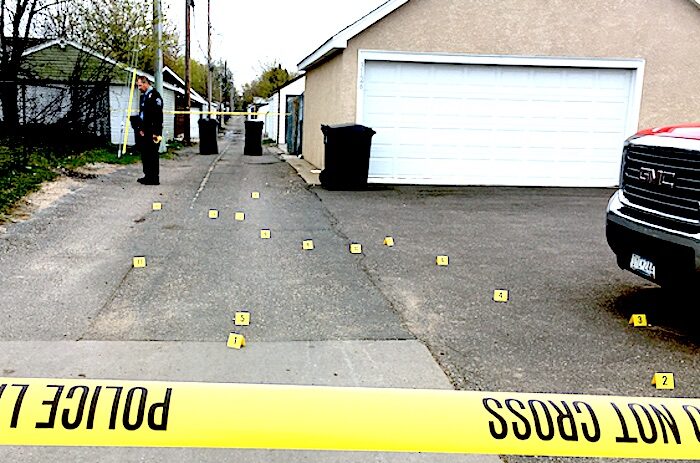
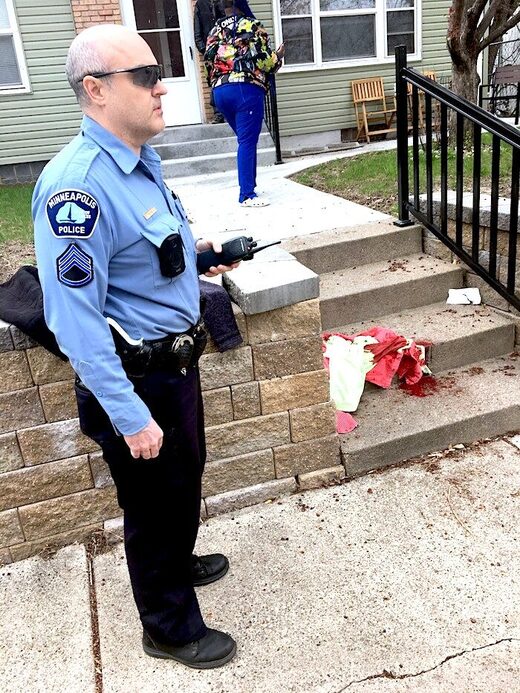
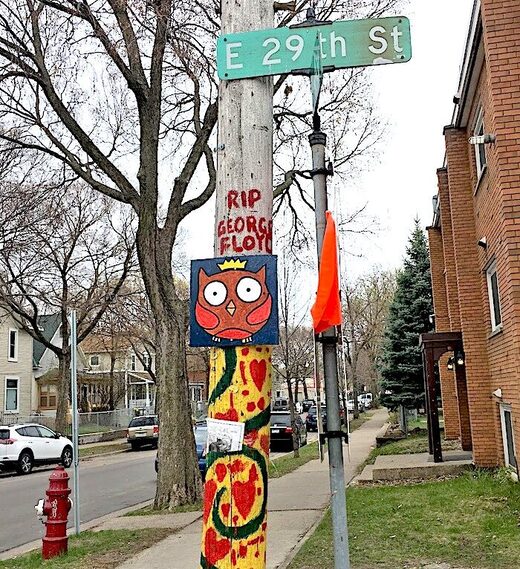
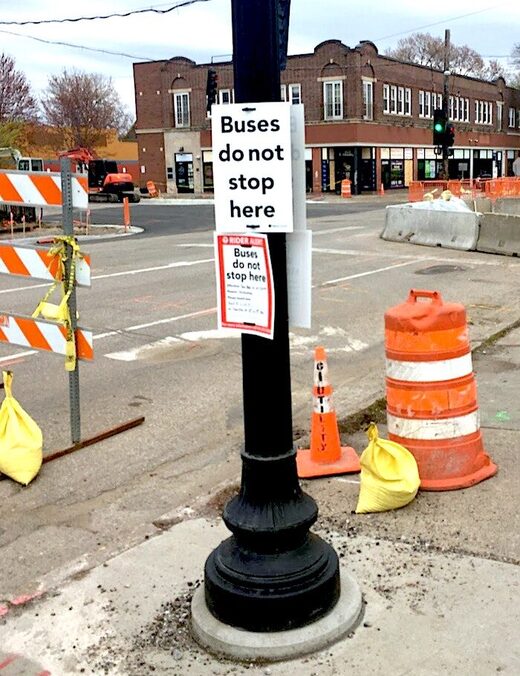
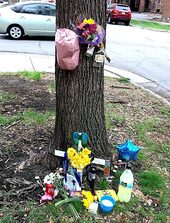



Reader Comments
RC